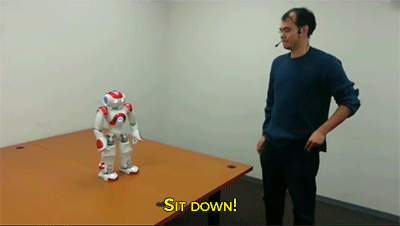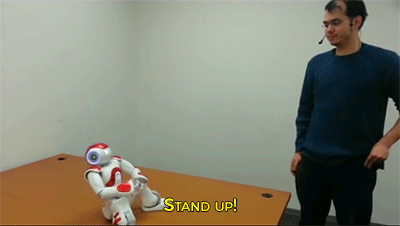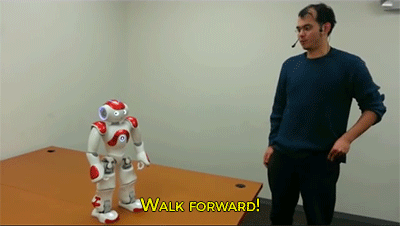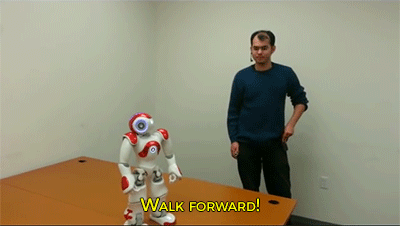Scientists Are Teaching This Robot To Say “No” Humans - Watch The Full Video




Scientists Are Teaching This Robot To Say “No” Humans - watch the full video
More Posts from Curiositytherover and Others

You’ve gotta see it in action.

For The First Time Ever, DNA Was Sequenced In Microgravity
Chasing Storms at 17,500mph
Flying 250 miles above the Earth aboard the International Space Station has given me the unique vantage point from which to view our planet. Spending a year in space has given me the unique opportunity to see a wide range of spectacular storm systems in space and on Earth.
The recent blizzard was remarkably visible from space. I took several photos of the first big storm system on Earth of year 2016 as it moved across the East Coast, Chicago and Washington D.C. Since my time here on the space station began in March 2015, I’ve been able to capture an array of storms on Earth and in space, ranging from hurricanes and dust storms to solar storms and most recently a rare thunder snowstorm.

Blizzard 2016

Hurricane Patricia 2015

Hurricane Joaquin 2015

Dust Storm in the Red Sea 2015

Dust Storm of Gobi Desert 2015

Aurora Solar Storm 2015

Aurora Solar Storm 2016

Thunderstorm over Italy 2015

Lightning and Aurora 2016

Rare Thunder Snowstorm 2016
Follow my Year In Space on Twitter, Facebook and Instagram.

Sky-piercing towers, Hyperloop transports, driverless cars, and 3D-printed buildings. Welcome to Dubai, the City of the Future.
Synthetic Muscles
Huntsville AL (SPX) Dec 31, 2015 Muscles are miracles of nature. They convert energy into motion more efficiently than any gasoline engine or electric motor. They’re extremely resilient and even heal themselves. Instead of degrading with use, our muscles become stronger the more we work them. Researchers have long sought a way to recreate that miracle in prosthetics. So far, no one has succeeded. But Lenore Rasmussen, Pri Full article



A major breakthrough could let both same-sex partners be biological parents to their kids
Could two same-sex partners ever be biologically related to one baby? Maybe. With a relatively new process called in vitro gametogenesis, or IVG, scientists could combine genetic material from both parents. While we may have to wait a bit for it — here’s how it works.

Liquid-metal terminators are generally something to be afraid of – but what if the substance was used to fight cancer instead of wiping out humanity?
That’s exactly what researchers in the US are working on, having developed a biodegradable liquid metal that can be used as a drug delivery technique to target cancer cells.
“The advance here is that we have a drug-delivery technique that may enhance the effectiveness of the drugs being delivered, can help doctors locate tumours, can be produced in bulk, and appears to be wholly biodegradable with very low toxicity,” said Zhen Gu, a biomedical engineer in a joint program at North Carolina’s State University and University at Chapel Hill. “And one of the advantages of this technique is that these liquid metal drug carriers – or ‘nano-terminators’ – are very easy to make.”
Continue Reading.

Researchers Discover Ultra-thin Diamond Nanothreads That Could Support Space Elevator
Today, in order to get to the Moon, an incredible logistical setup is required. From the training needed for astronauts, to the millions of dollars of equipment necessary for space travel, to the cost of rocket fuel—Space flight isn’t easy (or cheap). But what if one can reach the Moon by simply stepping into a small vehicle attached to a cable and pressing a button that says “Moon.”
If what you’re imagining is an elevator, then you are right.
It’s also an idea that several scientists have been trying to realize since 1895, and we have written a number of articles on the feasibility of this tech in the past. Now, with what researchers from the Pennsylvania State University discovered, we may be taking a step closer to achieving that idea.
When they applied alternating cycles of pressure to isolated, liquid-state benzene molecules, surprisingly, it was found that rings of carbon atoms assembled into neat and orderly chains, essentially forming strong ultra-thin diamond nanothreads.
Read more at: http://futurism.com/links/researchers-discover-ultra-thin-diamond-nanothreads-that-could-support-space-elevator/

This is the spaceship that could bring humans to Mars
Follow @the-future-now

The US space agency has just announced that it’ll be sticking four volunteers inside a tiny house for 30 days, as part of an experiment to test how isolation and “close quarters” affect people’s behaviour. Once inside, the volunteers can’t leave the cabin, and will only be able to regularly communicate with each other and NASA mission control (that means no Internet).
It sounds pretty uncomfortable, but if we want to make it further into space - all the way to Mars, for example - people are going to have to live in cramped spaces for months at a time with very little contact with the outside world, and scientists need to be able to predict the effects - including every little thing that could go wrong.
The compact, three-storey house that the volunteers will be living in is called the Human Research Exploration Analog (HERA), and it’s what NASA is calling a “science-making house”. That means there are lots of little experiments on board to keep the team occupied, like plants to grow and tiny shrimp to take care of.
-
 cuteundertrash liked this · 4 weeks ago
cuteundertrash liked this · 4 weeks ago -
 thebadoneout-1432 liked this · 1 month ago
thebadoneout-1432 liked this · 1 month ago -
 reflectedmind23 liked this · 1 month ago
reflectedmind23 liked this · 1 month ago -
 29odisea12estelar2008 liked this · 1 month ago
29odisea12estelar2008 liked this · 1 month ago -
 phantasm-27 reblogged this · 1 month ago
phantasm-27 reblogged this · 1 month ago -
 phantasm-27 liked this · 1 month ago
phantasm-27 liked this · 1 month ago -
 lunatika17 liked this · 1 month ago
lunatika17 liked this · 1 month ago -
 jbandcassy liked this · 1 month ago
jbandcassy liked this · 1 month ago -
 athenaoffantasy liked this · 1 month ago
athenaoffantasy liked this · 1 month ago -
 lostmyaccountliketheidiotiam liked this · 1 month ago
lostmyaccountliketheidiotiam liked this · 1 month ago -
 the-tiger-with-a-computer liked this · 1 month ago
the-tiger-with-a-computer liked this · 1 month ago -
 valeexpris606 reblogged this · 1 month ago
valeexpris606 reblogged this · 1 month ago -
 nyxnotnyc liked this · 1 month ago
nyxnotnyc liked this · 1 month ago -
 adriftinareverie reblogged this · 1 month ago
adriftinareverie reblogged this · 1 month ago -
 adriftinareverie liked this · 1 month ago
adriftinareverie liked this · 1 month ago -
 topaz616 reblogged this · 1 month ago
topaz616 reblogged this · 1 month ago -
 topaz616 liked this · 1 month ago
topaz616 liked this · 1 month ago -
 magicalprofessorsludgedeputy liked this · 1 month ago
magicalprofessorsludgedeputy liked this · 1 month ago -
 twila-9 reblogged this · 1 month ago
twila-9 reblogged this · 1 month ago -
 twila-9 liked this · 1 month ago
twila-9 liked this · 1 month ago -
 matrixprime liked this · 1 month ago
matrixprime liked this · 1 month ago -
 sany-wave liked this · 1 month ago
sany-wave liked this · 1 month ago -
 sideblogs-be-sideblogging reblogged this · 1 month ago
sideblogs-be-sideblogging reblogged this · 1 month ago -
 orionapraxnia liked this · 1 month ago
orionapraxnia liked this · 1 month ago -
 rt4q liked this · 1 month ago
rt4q liked this · 1 month ago -
 springtimeishere liked this · 1 month ago
springtimeishere liked this · 1 month ago -
 raileurta reblogged this · 1 month ago
raileurta reblogged this · 1 month ago -
 robotrules liked this · 4 months ago
robotrules liked this · 4 months ago -
 toniethephony liked this · 4 months ago
toniethephony liked this · 4 months ago -
 robo-guts reblogged this · 5 months ago
robo-guts reblogged this · 5 months ago -
 mintdropsss liked this · 5 months ago
mintdropsss liked this · 5 months ago -
 valeexpris606 reblogged this · 6 months ago
valeexpris606 reblogged this · 6 months ago -
 raileurta liked this · 6 months ago
raileurta liked this · 6 months ago -
 lunamikobrony2 liked this · 6 months ago
lunamikobrony2 liked this · 6 months ago -
 annau902a liked this · 7 months ago
annau902a liked this · 7 months ago -
 allthebestscreennamesaregone63 liked this · 7 months ago
allthebestscreennamesaregone63 liked this · 7 months ago -
 lynn-227 reblogged this · 7 months ago
lynn-227 reblogged this · 7 months ago -
 astrila reblogged this · 7 months ago
astrila reblogged this · 7 months ago -
 astrila liked this · 7 months ago
astrila liked this · 7 months ago -
 drstrangeloves liked this · 11 months ago
drstrangeloves liked this · 11 months ago -
 another-void-creature-yippers liked this · 1 year ago
another-void-creature-yippers liked this · 1 year ago -
 sweetninjamilkshake liked this · 1 year ago
sweetninjamilkshake liked this · 1 year ago -
 teacup-universe reblogged this · 1 year ago
teacup-universe reblogged this · 1 year ago -
 teacup-universe liked this · 1 year ago
teacup-universe liked this · 1 year ago